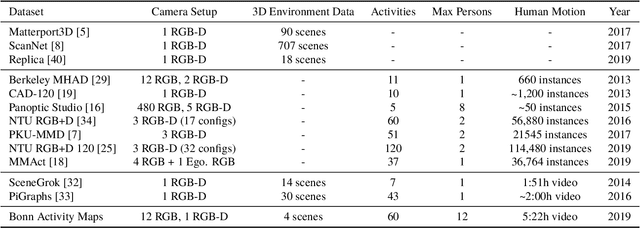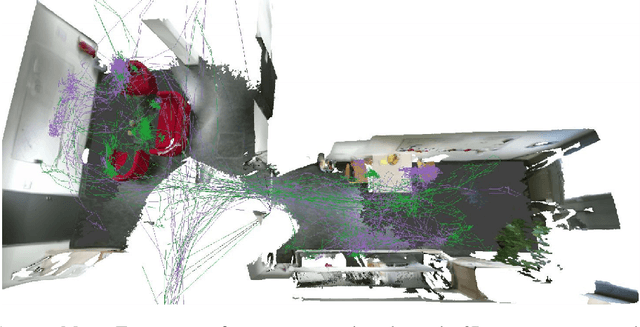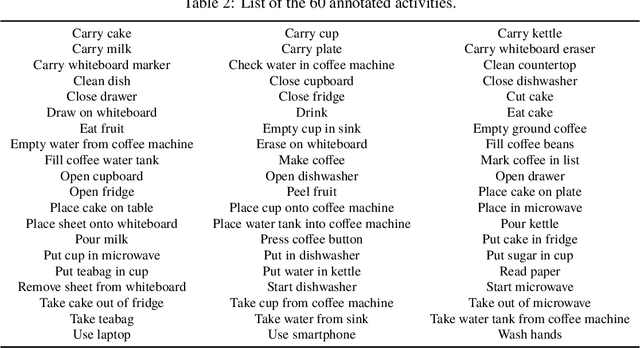Patrick Stotko
ROSA: Reconstructing Object Shape and Appearance Textures by Adaptive Detail Transfer
Jan 30, 2025



Abstract:Reconstructing an object's shape and appearance in terms of a mesh textured by a spatially-varying bidirectional reflectance distribution function (SVBRDF) from a limited set of images captured under collocated light is an ill-posed problem. Previous state-of-the-art approaches either aim to reconstruct the appearance directly on the geometry or additionally use texture normals as part of the appearance features. However, this requires detailed but inefficiently large meshes, that would have to be simplified in a post-processing step, or suffers from well-known limitations of normal maps such as missing shadows or incorrect silhouettes. Another limiting factor is the fixed and typically low resolution of the texture estimation resulting in loss of important surface details. To overcome these problems, we present ROSA, an inverse rendering method that directly optimizes mesh geometry with spatially adaptive mesh resolution solely based on the image data. In particular, we refine the mesh and locally condition the surface smoothness based on the estimated normal texture and mesh curvature. In addition, we enable the reconstruction of fine appearance details in high-resolution textures through a pioneering tile-based method that operates on a single pre-trained decoder network but is not limited by the network output resolution.
NeRFs are Mirror Detectors: Using Structural Similarity for Multi-View Mirror Scene Reconstruction with 3D Surface Primitives
Jan 07, 2025



Abstract:While neural radiance fields (NeRF) led to a breakthrough in photorealistic novel view synthesis, handling mirroring surfaces still denotes a particular challenge as they introduce severe inconsistencies in the scene representation. Previous attempts either focus on reconstructing single reflective objects or rely on strong supervision guidance in terms of additional user-provided annotations of visible image regions of the mirrors, thereby limiting the practical usability. In contrast, in this paper, we present NeRF-MD, a method which shows that NeRFs can be considered as mirror detectors and which is capable of reconstructing neural radiance fields of scenes containing mirroring surfaces without the need for prior annotations. To this end, we first compute an initial estimate of the scene geometry by training a standard NeRF using a depth reprojection loss. Our key insight lies in the fact that parts of the scene corresponding to a mirroring surface will still exhibit a significant photometric inconsistency, whereas the remaining parts are already reconstructed in a plausible manner. This allows us to detect mirror surfaces by fitting geometric primitives to such inconsistent regions in this initial stage of the training. Using this information, we then jointly optimize the radiance field and mirror geometry in a second training stage to refine their quality. We demonstrate the capability of our method to allow the faithful detection of mirrors in the scene as well as the reconstruction of a single consistent scene representation, and demonstrate its potential in comparison to baseline and mirror-aware approaches.
RHINO-VR Experience: Teaching Mobile Robotics Concepts in an Interactive Museum Exhibit
Mar 22, 2024



Abstract:In 1997, the very first tour guide robot RHINO was deployed in a museum in Germany. With the ability to navigate autonomously through the environment, the robot gave tours to over 2,000 visitors. Today, RHINO itself has become an exhibit and is no longer operational. In this paper, we present RHINO-VR, an interactive museum exhibit using virtual reality (VR) that allows museum visitors to experience the historical robot RHINO in operation in a virtual museum. RHINO-VR, unlike static exhibits, enables users to familiarize themselves with basic mobile robotics concepts without the fear of damaging the exhibit. In the virtual environment, the user is able to interact with RHINO in VR by pointing to a location to which the robot should navigate and observing the corresponding actions of the robot. To include other visitors who cannot use the VR, we provide an external observation view to make RHINO visible to them. We evaluated our system by measuring the frame rate of the VR simulation, comparing the generated virtual 3D models with the originals, and conducting a user study. The user-study showed that RHINO-VR improved the visitors' understanding of the robot's functionality and that they would recommend experiencing the VR exhibit to others.
FPO++: Efficient Encoding and Rendering of Dynamic Neural Radiance Fields by Analyzing and Enhancing Fourier PlenOctrees
Oct 31, 2023Abstract:Fourier PlenOctrees have shown to be an efficient representation for real-time rendering of dynamic Neural Radiance Fields (NeRF). Despite its many advantages, this method suffers from artifacts introduced by the involved compression when combining it with recent state-of-the-art techniques for training the static per-frame NeRF models. In this paper, we perform an in-depth analysis of these artifacts and leverage the resulting insights to propose an improved representation. In particular, we present a novel density encoding that adapts the Fourier-based compression to the characteristics of the transfer function used by the underlying volume rendering procedure and leads to a substantial reduction of artifacts in the dynamic model. Furthermore, we show an augmentation of the training data that relaxes the periodicity assumption of the compression. We demonstrate the effectiveness of our enhanced Fourier PlenOctrees in the scope of quantitative and qualitative evaluations on synthetic and real-world scenes.
TraM-NeRF: Tracing Mirror and Near-Perfect Specular Reflections through Neural Radiance Fields
Oct 16, 2023Abstract:Implicit representations like Neural Radiance Fields (NeRF) showed impressive results for photorealistic rendering of complex scenes with fine details. However, ideal or near-perfectly specular reflecting objects such as mirrors, which are often encountered in various indoor scenes, impose ambiguities and inconsistencies in the representation of the reconstructed scene leading to severe artifacts in the synthesized renderings. In this paper, we present a novel reflection tracing method tailored for the involved volume rendering within NeRF that takes these mirror-like objects into account while avoiding the cost of straightforward but expensive extensions through standard path tracing. By explicitly modeling the reflection behavior using physically plausible materials and estimating the reflected radiance with Monte-Carlo methods within the volume rendering formulation, we derive efficient strategies for importance sampling and the transmittance computation along rays from only few samples. We show that our novel method enables the training of consistent representations of such challenging scenes and achieves superior results in comparison to previous state-of-the-art approaches.
Efficient 3D Reconstruction, Streaming and Visualization of Static and Dynamic Scene Parts for Multi-client Live-telepresence in Large-scale Environments
Nov 25, 2022Abstract:Despite the impressive progress of telepresence systems for room-scale scenes with static and dynamic scene entities, expanding their capabilities to scenarios with larger dynamic environments beyond a fixed size of a few squaremeters remains challenging. In this paper, we aim at sharing 3D live-telepresence experiences in large-scale environments beyond room scale with both static and dynamic scene entities at practical bandwidth requirements only based on light-weight scene capture with a single moving consumer-grade RGB-D camera. To this end, we present a system which is built upon a novel hybrid volumetric scene representation in terms of the combination of a voxel-based scene representation for the static contents, that not only stores the reconstructed surface geometry but also contains information about the object semantics as well as their accumulated dynamic movement over time, and a point-cloud-based representation for dynamic scene parts, where the respective separation from static parts is achieved based on semantic and instance information extracted for the input frames. With an independent yet simultaneous streaming of both static and dynamic content, where we seamlessly integrate potentially moving but currently static scene entities in the static model until they are becoming dynamic again, as well as the fusion of static and dynamic data at the remote client, our system is able to achieve VR-based live-telepresence at interactive rates. Our evaluation demonstrates the potential of our novel approach in terms of visual quality, performance, and ablation studies regarding involved design choices.
Incomplete Gamma Kernels: Generalizing Locally Optimal Projection Operators
May 02, 2022



Abstract:We present incomplete gamma kernels, a generalization of Locally Optimal Projection (LOP) operators. In particular, we reveal the relation of the classical localized $ L_1 $ estimator, used in the LOP operator for surface reconstruction from noisy point clouds, to the common Mean Shift framework via a novel kernel. Furthermore, we generalize this result to a whole family of kernels that are built upon the incomplete gamma function and each represents a localized $ L_p $ estimator. By deriving various properties of the kernel family concerning distributional, Mean Shift induced, and other aspects such as strict positive definiteness, we obtain a deeper understanding of the operator's projection behavior. From these theoretical insights, we illustrate several applications ranging from an improved Weighted LOP (WLOP) density weighting scheme and a more accurate Continuous LOP (CLOP) kernel approximation to the definition of a novel set of robust loss functions. These incomplete gamma losses include the Gaussian and LOP loss as special cases and can be applied for reconstruction tasks such as normal filtering. We demonstrate the effects of each application in a range of quantitative and qualitative experiments that highlight the benefits induced by our modifications.
Bonn Activity Maps: Dataset Description
Dec 13, 2019



Abstract:The key prerequisite for accessing the huge potential of current machine learning techniques is the availability of large databases that capture the complex relations of interest. Previous datasets are focused on either 3D scene representations with semantic information, tracking of multiple persons and recognition of their actions, or activity recognition of a single person in captured 3D environments. We present Bonn Activity Maps, a large-scale dataset for human tracking, activity recognition and anticipation of multiple persons. Our dataset comprises four different scenes that have been recorded by time-synchronized cameras each only capturing the scene partially, the reconstructed 3D models with semantic annotations, motion trajectories for individual people including 3D human poses as well as human activity annotations. We utilize the annotations to generate activity likelihoods on the 3D models called activity maps.
A VR System for Immersive Teleoperation and Live Exploration with a Mobile Robot
Aug 08, 2019



Abstract:Applications like disaster management and industrial inspection often require experts to enter contaminated places. To circumvent the need for physical presence, it is desirable to generate a fully immersive individual live teleoperation experience. However, standard video-based approaches suffer from a limited degree of immersion and situation awareness due to the restriction to the camera view, which impacts the navigation. In this paper, we present a novel VR-based practical system for immersive robot teleoperation and scene exploration. While being operated through the scene, a robot captures RGB-D data that is streamed to a SLAM-based live multi-client telepresence system. Here, a global 3D model of the already captured scene parts is reconstructed and streamed to the individual remote user clients where the rendering for e.g. head-mounted display devices (HMDs) is performed. We introduce a novel lightweight robot client component which transmits robot-specific data and enables a quick integration into existing robotic systems. This way, in contrast to first-person exploration systems, the operators can explore and navigate in the remote site completely independent of the current position and view of the capturing robot, complementing traditional input devices for teleoperation. We provide a proof-of-concept implementation and demonstrate the capabilities as well as the performance of our system regarding interactive object measurements and bandwidth-efficient data streaming and visualization. Furthermore, we show its benefits over purely video-based teleoperation in a user study revealing a higher degree of situation awareness and a more precise navigation in challenging environments.
 Add to Chrome
Add to Chrome Add to Firefox
Add to Firefox Add to Edge
Add to Edge